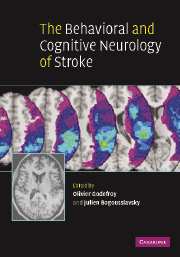Book contents
- Frontmatter
- Contents
- Contributors
- Preface
- 1 Evaluation of cognitive and behavioral disorders in the stroke unit
- Motor and gestural disorders
- Aphasia and arthric disorders
- Hemineglect, Anton–Babinski and right hemisphere syndromes
- Agnosia and Bálint's syndrome
- Executive and memory disorders
- Behavioral and mood disorders
- 22 Akinetic mutism and related disorders
- 23 Alterations of level of consciousness related to stroke
- 24 Delirium and confusional state in stroke patients
- 25 Post-stroke delusion
- 26 Acute behavioral and mood changes
- 27 Stroke and personality change
- 28 Post-stroke mania
- 29 Depression after stroke
- 30 Fatigue
- Dementia and anatomical left/right syndromes
- Index
- References
23 - Alterations of level of consciousness related to stroke
Published online by Cambridge University Press: 10 October 2009
- Frontmatter
- Contents
- Contributors
- Preface
- 1 Evaluation of cognitive and behavioral disorders in the stroke unit
- Motor and gestural disorders
- Aphasia and arthric disorders
- Hemineglect, Anton–Babinski and right hemisphere syndromes
- Agnosia and Bálint's syndrome
- Executive and memory disorders
- Behavioral and mood disorders
- 22 Akinetic mutism and related disorders
- 23 Alterations of level of consciousness related to stroke
- 24 Delirium and confusional state in stroke patients
- 25 Post-stroke delusion
- 26 Acute behavioral and mood changes
- 27 Stroke and personality change
- 28 Post-stroke mania
- 29 Depression after stroke
- 30 Fatigue
- Dementia and anatomical left/right syndromes
- Index
- References
Summary
Introduction
Alteration of level of consciousness (ALC), which comprises deficient arousal, stupor, and rarely deep coma, is frequent at the acute stage of stroke. These conditions may cause fluctuating, fixed, or fast decrease of consciousness level, which in turn interferes with a detailed bedside neurological examination and neuropsychological assessment. Conversely, ALC constitutes a useful complementary sign both for the localization (syndrome) and cause (etiology) of cerebrovascular diseases (Adams, 1997). A typical example is the examination of a stuporous old patient with high blood pressure (220/120 mmHg), showing an ataxic hypesthetic hemiparesis with asterixis, bilateral Babinski signs, whereas neuro-ophthalmological evaluation of his (forced open) eyes reveals an upgaze palsy with downward gaze deviation: this stroke pattern suggests a contralateral large thalamic (syndrome) hemorrhage (etiology), as illustrated in Figure 23.1.
Patients who develop ALC, ranging from somnolence to stupor and coma, need immediate admission to the intensive care unit (ICU), particularly those without upper airways protection, absent gag reflex, and/or a Coma Glasgow Scale (CGS) below or equal to 6 (see later). Indeed, endotracheal intubation is mandatory in these cases before further CT-scan or MR imaging (MRI) studies, EEG and laboratory tests – i.e. hematocrit, electrolytes with quick capillary glucose, osmolality; renal, hepatic, arterial blood gases (pH, PCO2, PO2, HCO3, HbCO, lactate), coagulations tests (aPTT, INR, platelets, smear, fibrinogen with fibrin degeneration products, d-dimer), blood and urine toxic screening, thyroid and hypophyse functions screening.
- Type
- Chapter
- Information
- The Behavioral and Cognitive Neurology of Stroke , pp. 455 - 488Publisher: Cambridge University PressPrint publication year: 2007



